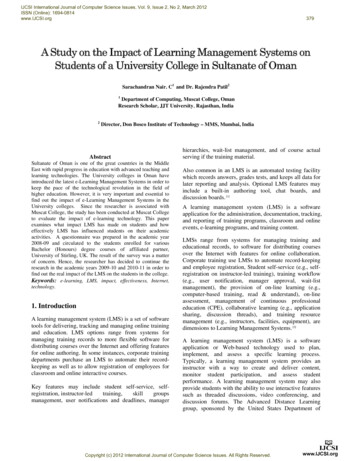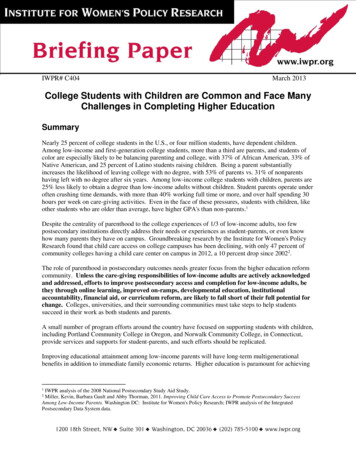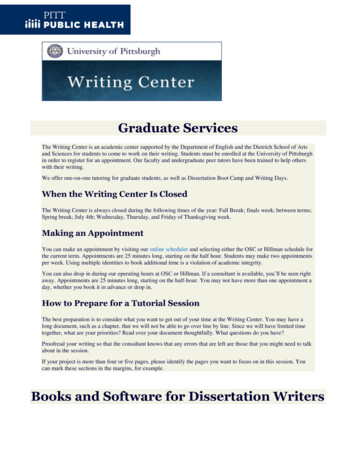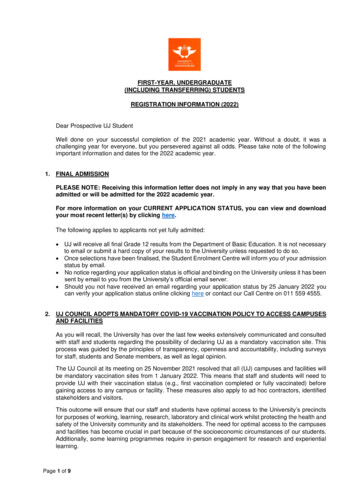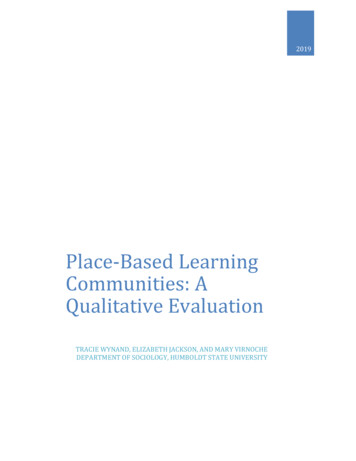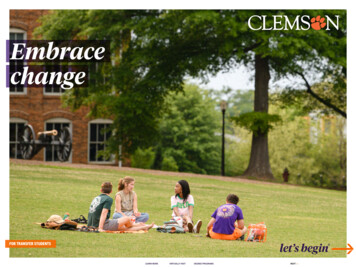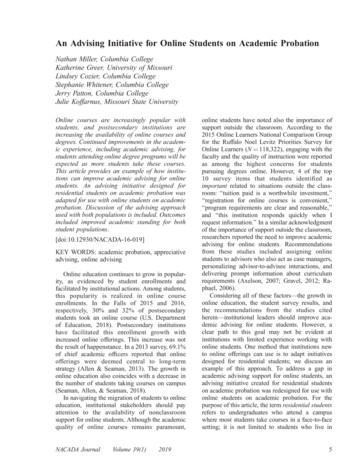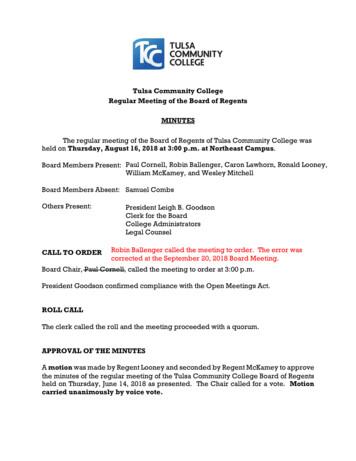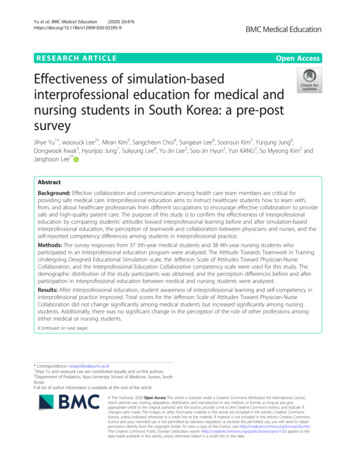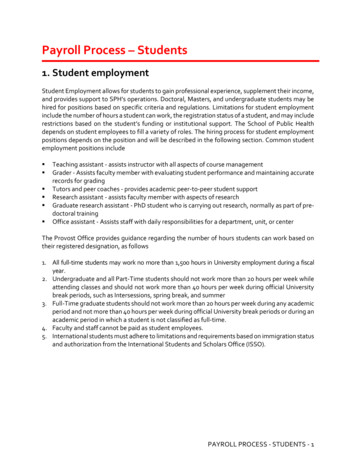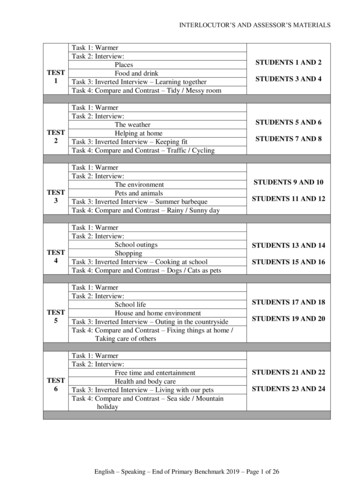
Transcription
INTERLOCUTOR’S AND ASSESSOR’S MATERIALSTask 1: WarmerTask 2: Interview:PlacesTESTFood and drink1Task 3: Inverted Interview – Learning togetherTask 4: Compare and Contrast – Tidy / Messy roomTask 1: WarmerTask 2: Interview:The weatherTESTHelping at home2Task 3: Inverted Interview – Keeping fitTask 4: Compare and Contrast – Traffic / CyclingTask 1: WarmerTask 2: Interview:The environmentTESTPets and animals3Task 3: Inverted Interview – Summer barbequeTask 4: Compare and Contrast – Rainy / Sunny dayTask 1: WarmerTask 2: Interview:School outingsTESTShopping4Task 3: Inverted Interview – Cooking at schoolTask 4: Compare and Contrast – Dogs / Cats as petsTask 1: WarmerTask 2: Interview:School lifeTESTHouse and home environment5Task 3: Inverted Interview – Outing in the countrysideTask 4: Compare and Contrast – Fixing things at home /Taking care of othersTask 1: WarmerTask 2: Interview:Free time and entertainmentTESTHealth and body care6Task 3: Inverted Interview – Living with our petsTask 4: Compare and Contrast – Sea side / MountainholidaySTUDENTS 1 AND 2STUDENTS 3 AND 4STUDENTS 5 AND 6STUDENTS 7 AND 8STUDENTS 9 AND 10STUDENTS 11 AND 12STUDENTS 13 AND 14STUDENTS 15 AND 16STUDENTS 17 AND 18STUDENTS 19 AND 20STUDENTS 21 AND 22STUDENTS 23 AND 24English – Speaking – End of Primary Benchmark 2019 – Page 1 of 26
INTERLOCUTOR’S AND ASSESSOR’S MATERIALSTask 1: WarmerTask 2: Interview:SportsTESTPeople who help us7Task 3: Inverted Interview – Music in our free timeTask 4: Compare and Contrast – Laying the table /Washing the dishesTask 1: WarmerTask 2: Interview:School activitiesTESTYou and others8Task 3: Inverted Interview – Fun in the waterTask 4: Compare and Contrast – Shopping for groceries /Shopping for sport shoesSTUDENTS 25 AND 26STUDENTS 27 AND 28STUDENTS 29 AND 30STUDENTS 31 AND 32English – Speaking – End of Primary Benchmark 2019 – Page 2 of 26
INTERLOCUTOR’S AND ASSESSOR’S MATERIALSTEST 1 – TASK 1 – WARMER1 MINUTE – NOT ASSESSEDThe interlocutor greets the students and asks them to take a seat.The interlocutor puts the students at ease by engaging them one at a time in a brief and informalconversation about a topic of interest to the student, such as the place where they live, theirfavourite month or season, and things they do after school or at the weekend.TEST 1 – TASK 2 – INTERVIEW3 MINUTES TOTALThe interlocutor asks questions on one topic per student at a time as indicated below.To Student A:The interlocutor says: “I’m going to ask you some questions about Places.”1.2.3.Which places do you like to visit in your free time? Why?Tell me about a place you have been to recently. Describe the place and say something aboutwhat you did there.Imagine that you could go anywhere in the world. Where would that be and why?To Student B:The interlocutor says: “I’m going to ask you some questions about Food and drink.”1.2.3.What’s your favourite dish? Describe it for me.Is there any food which you dislike? Why?Imagine you are going on a picnic with your friends. What food and drink would you takewith you? Why?English – Speaking – End of Primary Benchmark 2019 – Page 3 of 26
INTERLOCUTOR’S AND ASSESSOR’S MATERIALSTEST 1 – TASK 3 – INVERTED INTERVIEW3 MINUTES TOTALThe interlocutor tells the students while placing the picture in front of them: “I want you tolook at this picture. Now, I know the people in the picture. You can ask me questions aboutthem and I will answer. Have you understood? Would you like to know about them?”The interlocutor prompts each student to ask a question in turn.If a student does not know what to ask, the interlocutor can use prompts such as:Ask me about - The place- The situation- The relationship between these children and / or the children and the adult- Their feelings at this moment- The moments just before the picture was taken- What happened after the picture was taken- What their friends said to them after this happened- Their hobbies; free time; family; home- My opinion of the situation you can see in this picture- Is there anything else you wish to ask me about this picture?English – Speaking – End of Primary Benchmark 2019 – Page 4 of 26
INTERLOCUTOR’S AND ASSESSOR’S MATERIALSTEST 1 – TASK 4 – COMPARE AND CONTRAST3 MINUTES TOTALThe interlocutor says: “Look carefully at these two pictures and I will ask you both somequestions about them.”1ATo Student A: How are these two pictures alike?1BTo Student B: How are they different?2ATo Student A: Look at the first picture.a) What kind of room is this?b) How would you take care of this room if it were yours?c) Would you like to sleep in a room like this? Why? / Why not?2BTo Student B: Look at the second picture.a) What kind of room is this?b) What would you do if this room were yours?c) Would you like to spend time in a room like this? Why?Student AStudent BThe interlocutor says: “The test is over. You may now leave the room.”English – Speaking – End of Primary Benchmark 2019 – Page 5 of 26
INTERLOCUTOR’S AND ASSESSOR’S MATERIALSTEST 2 – TASK 1 – WARMER1 MINUTE – NOT ASSESSEDThe interlocutor greets the students and asks them to take a seat.The interlocutor puts the students at ease by engaging them one at a time in a brief and informalconversation about a topic of interest to the student, such as the place where they live, theirfavourite month or season, and things they do after school or at the weekend.TEST 2 – TASK 2 – INTERVIEW3 MINUTES TOTALThe interlocutor asks questions on one topic per student at a time as indicated below.To Student A:The interlocutor says: “I’m going to ask you some questions about The weather.”1.2.3.How has the weather been like recently?Do you prefer cold wintry days or hot sunny days? Why? What do you usually do on thesedays?Imagine that you were going on a hike in spring. What would you wear? Why?To Student B:The interlocutor says: “I’m going to ask you some questions about Helping at home.”1.2.3.How do you help others at home?Tell me about the chore you like least. Why?Imagine you are grown up and have your own home. How would you keep it clean? Why?English – Speaking – End of Primary Benchmark 2019 – Page 6 of 26
INTERLOCUTOR’S AND ASSESSOR’S MATERIALSTEST 2 – TASK 3 – INVERTED INTERVIEW3 MINUTES TOTALThe interlocutor tells the students while placing the picture in front of them: “I want you tolook at this picture. Now, I know the people in the picture. You can ask me questions aboutthem and I will answer. Have you understood? Would you like to know about them?”The interlocutor prompts each student to ask a question in turn.If a student does not know what to ask, the interlocutor can use prompts such as:Ask me about - The place- The event- The relationship between these young people- Their feelings at this moment- The moments just before the picture was taken- What happened after the picture was taken- What their friends said to them after the event- Their hobbies; free time; family; home- My opinion of the event you can see in this picture- Is there anything else you wish to ask me about this picture?English – Speaking – End of Primary Benchmark 2019 – Page 7 of 26
INTERLOCUTOR’S AND ASSESSOR’S MATERIALSTEST 2 – TASK 4 – COMPARE AND CONTRAST3 MINUTES TOTALThe interlocutor says: “Look carefully at these two pictures and I will ask you both somequestions about them.”1ATo Student A: How are these two pictures alike?1BTo Student B: How are they different?2ATo Student A: Look at the first picture.a) What kind of street is this?b) Is it better to walk or drive? Why?c) How would you take care of the environment when you grow up?2BTo Student B: Look at the second picture.a) What kind of place is this?b) How would cycling to school be better for the environment?c) Would you enjoy living in a car free town? Why / Why not?Student AStudent BThe interlocutor says: “The test is over. You may now leave the room.”English – Speaking – End of Primary Benchmark 2019 – Page 8 of 26
INTERLOCUTOR’S AND ASSESSOR’S MATERIALSTEST 3 – TASK 1 – WARMER1 MINUTE – NOT ASSESSEDThe interlocutor greets the students and asks them to take a seat.The interlocutor puts the students at ease by engaging them one at a time in a brief and informalconversation about a topic of interest to the student, such as the place where they live, theirfavourite month or season, and things they do after school or at the weekend.TEST 3 – TASK 2 – INTERVIEW3 MINUTES TOTALThe interlocutor asks questions on one topic per student at a time as indicated below.To Student A:The Interlocutor says: “I’m going to ask you some questions about The environment.”1.2.3.Describe the place where you live. Do you like it? Why / Why not?What can a school do to take care of the environment?Do you prefer to spend time by the sea or in the countryside? Why?To Student B:The interlocutor says: “I’m going to ask you some questions about Pets and animals.”1.2.3.Describe the wild animal you like most. (Ask: Why do you like it most?)Do you have any pets? (If the answer is “Yes”, ask: How do you take care of your pet/s?)(If the answer is “No”, ask: If you were to have a pet what would you prefer? Why?)Imagine you found an injured bird in the street. What would you do? Why?English – Speaking – End of Primary Benchmark 2019 – Page 9 of 26
INTERLOCUTOR’S AND ASSESSOR’S MATERIALSTEST 3 – TASK 3 – INVERTED INTERVIEW3 MINUTES TOTALThe interlocutor tells the students while placing the picture in front of them: “I want you tolook at this picture. Now, I know the people in the picture. You can ask me questions aboutthem and I will answer. Have you understood? Would you like to know about them?”The interlocutor prompts each student to ask a question in turn.If a student does not know what to ask, the interlocutor can use prompts such as:Ask me about - The place- The event- The relationship between these children and / or the children and the adults- Their feelings at this moment- The moments just before the picture was taken- What happened after the picture was taken- What their friends said to them after this happened- Their hobbies; free time; family; home- My opinion of the event you can see in this picture- Is there anything else you wish to ask me about this picture?English – Speaking – End of Primary Benchmark 2019 – Page 10 of 26
INTERLOCUTOR’S AND ASSESSOR’S MATERIALSTEST 3 – TASK 4 – COMPARE AND CONTRAST3 MINUTES TOTALThe interlocutor says: “Look carefully at these two pictures and I will ask you both somequestions about them.”1ATo Student A: How are these two pictures alike?1BTo Student B: How are they different?2ATo Student A: Look at the first picture.a)b)c)2BWhat season do you think it is? Why?What would you wear on a day like this?Would you like to go for a walk on a day like this? Why / Why not?To Student B: Look at the second picture.a)b)c)Student AWhat time of year do you think this is? Why?What would you wear on a day like this?Would you like to go for a walk on a day like this? Why / Why not?Student BThe interlocutor says: “The test is over. You may now leave the room.”English – Speaking – End of Primary Benchmark 2019 – Page 11 of 26
INTERLOCUTOR’S AND ASSESSOR’S MATERIALSTEST 4 – TASK 1 – WARMER1 MINUTE – NOT ASSESSEDThe interlocutor greets the students and asks them to take a seat.The interlocutor puts the students at ease by engaging them one at a time in a brief and informalconversation about a topic of interest to the student, such as the place where they live, theirfavourite month or season, and things they do after school or at the weekend.TEST 4 – TASK 2 – INTERVIEW3 MINUTES TOTALThe interlocutor asks questions on one topic per student at a time as indicated below.To Student A:The interlocutor says: “I’m going to ask you some questions about School outings.”1.2.3.Describe a school outing you have been on. (Prompt: When? Where? What?)Would you prefer to visit a historical site or a science museum? Why?Your teacher asked you where you would like to go to on a school outing. Where would yousuggest? Why?To Student B:The interlocutor says: “I’m going to ask you some questions about Shopping.”1.2.3.What kind of things do you like going shopping for?Is there a shop you don’t like going to? Why?Imagine you had your own shop. What would it be like?English – Speaking – End of Primary Benchmark 2019 – Page 12 of 26
INTERLOCUTOR’S AND ASSESSOR’S MATERIALSTEST 4 – TASK 3 – INVERTED INTERVIEW3 MINUTES TOTALThe interlocutor tells the students while placing the picture in front of them: “I want you tolook at this picture. Now, I know the people in the picture. You can ask me questions aboutthem and I will answer. Have you understood? Would you like to know about them?”The interlocutor prompts each student to ask a question in turn.If a student does not know what to ask, the interlocutor can use prompts such as:Ask me about - The place- The event- The relationship between these children and / or the children and the adult- Their feelings at this moment- The moments just before the picture was taken- What happened after the picture was taken- What their friends said to them after this happened- Their hobbies; free time; family; home- My opinion of the situation you can see in this picture- Is there anything else you wish to ask me about this picture?English – Speaking – End of Primary Benchmark 2019 – Page 13 of 26
INTERLOCUTOR’S AND ASSESSOR’S MATERIALSTEST 4 – TASK 4 – COMPARE AND CONTRAST3 MINUTES TOTALThe interlocutor says: “Look carefully at these two pictures and I will ask you both somequestions about them.”1ATo Student A: How are these two pictures alike?1BTo Student B: How are they different?2ATo Student A: Look at the first picture.a) What do you think makes this dog so loveable?b) How would you take care of this dog if it were yours?c) Would you like to receive a pet as a gift? Why / Why not?2BTo Student B: Look at the second picture.a) What do you think makes this cat so loveable?b) How would you take care of this cat if it were yours?c) Would you play with this cat in the same way as you would with a large dog? Why /Why not?Student AStudent BThe interlocutor says: “The test is over. You may now leave the room.”English – Speaking – End of Primary Benchmark 2019 – Page 14 of 26
INTERLOCUTOR’S AND ASSESSOR’S MATERIALSTEST 5 – TASK 1 – WARMER1 MINUTE – NOT ASSESSEDThe interlocutor greets the students and asks them to take a seat.The interlocutor puts the students at ease by engaging them one at a time in a brief and informalconversation about a topic of interest to the student, such as the place where they live, theirfavourite month or season, and things they do after school or at the weekend.TEST 5 – TASK 2 – INTERVIEW3 MINUTES TOTALThe interlocutor asks questions on one topic per student at a time as indicated below.To Student A:The interlocutor says: “I’m going to ask you some questions about School life.”1.2.3.What part of your school day do you like most? Why? (Prompt: morning/ break time /afternoon)Describe your classroom.Imagine your teacher asked you to choose between an indoor and outdoor activity. Whatwould you choose? Why?To Student B:The interlocutor says: “I’m going to ask you some questions about House and homeenvironment.”1.2.3.Where do you do your homework? Why?Describe your favourite room at home.Imagine you had a tree house in your garden, where you could spend your free time. Whatwould it look like? (Prompt: how to get up there, objects, games you play )English – Speaking – End of Primary Benchmark 2019 – Page 15 of 26
INTERLOCUTOR’S AND ASSESSOR’S MATERIALSTEST 5 – TASK 3 – INVERTED INTERVIEW3 MINUTES TOTALThe interlocutor tells the students while placing the picture in front of them: “I want you tolook at this picture. Now, I know the people in the picture. You can ask me questions aboutthem and I will answer. Have you understood? Would you like to know about them?”The interlocutor prompts each student to ask a question in turn.If a student does not know what to ask, the interlocutor can use prompts such as:Ask me about - The place- The event- The relationship between these children- Their feelings at this moment- The moments just before the picture was taken- What happened after the picture was taken- What their friends said to them after this happened- Their hobbies; free time; family; home- My opinion of the event you can see in this picture- Is there anything else you wish to ask me about this picture?English – Speaking – End of Primary Benchmark 2019 – Page 16 of 26
INTERLOCUTOR’S AND ASSESSOR’S MATERIALSTEST 5 – TASK 4 – COMPARE AND CONTRAST3 MINUTES TOTALThe interlocutor says: “Look carefully at these two pictures and I will ask you both somequestions about them.”1ATo Student A: How are these two pictures alike?1BTo Student B: How are they different?2ATo Student A: Look at the first picture.a) Why would you need someone to fix the water pipe?b) How can we save water at home?c) Do you think this is an interesting job? Why / Why not?2BTo Student B: Look at the second picture.a) Why would you need someone to take care of you?b) How do doctors and nurses help us when we are sick?c) Do you think this is an interesting job? Why / Why not?Student AStudent BThe interlocutor says: “The test is over. You may now leave the room.”English – Speaking – End of Primary Benchmark 2019 – Page 17 of 26
INTERLOCUTOR’S AND ASSESSOR’S MATERIALSTEST 6 – TASK 1 – WARMER1 MINUTE – NOT ASSESSEDThe interlocutor greets the students and asks them to take a seat.The interlocutor puts the students at ease by engaging them one at a time in a brief and informalconversation about a topic of interest to the student, such as the place where they live, theirfavourite month or season, and things they do after school or at the weekend.TEST 6 – TASK 2 – INTERVIEW3 MINUTES TOTALThe interlocutor asks questions on one topic per student at a time as indicated below.To Student A:The interlocutor says: “I’m going to ask you some questions about Free time andentertainment.”1.2.3.What do you enjoy doing during the weekend? Why?Talk to me about one of your hobbies. (Prompt a different answer from the previous.)Imagine you were to start a new hobby. What would it be? Why?To Student B:The interlocutor says: “I’m going to ask you some questions about Health and body care.”1.2.3.What should you eat to be healthy? Why?How often do you exercise? Why is it important to be physically active?Imagine you were to join a sport club. How often and at what time would you go there? Why?English – Speaking – End of Primary Benchmark 2019 – Page 18 of 26
INTERLOCUTOR’S AND ASSESSOR’S MATERIALSTEST 6 – TASK 3 – INVERTED INTERVIEW3 MINUTES TOTALThe interlocutor tells the students while placing the picture in front of them: “I want you tolook at this picture. Now, I know the people in the picture. You can ask me questions aboutthem and I will answer. Have you understood? Would you like to know about them?”The interlocutor prompts each student to ask a question in turn.If a student does not know what to ask, the interlocutor can use prompts such as:Ask me about - The place- The situation- The relationship between these people- Their feelings at this moment- The moments just before the picture was taken- What happened after the picture was taken- What their friends said to them after this happened- Their hobbies; free time; family; home- My opinion of the situation you can see in this picture- Is there anything else you wish to ask me about this picture?English – Speaking – End of Primary Benchmark 2019 – Page 19 of 26
INTERLOCUTOR’S AND ASSESSOR’S MATERIALSTEST 6 – TASK 4 – COMPARE AND CONTRAST3 MINUTES TOTALThe interlocutor says: “Look carefully at these two pictures and I will ask you both somequestions about them.”1ATo Student A: How are these two pictures alike?1BTo Student B: How are they different?2ATo Student A: Look at the first picture.a) What kind of place is this?b) What would you enjoy doing if you were on holiday in a place like this?c) Would you prefer a holiday in a quiet or a busy place? Why?2BTo Student B: Look at the second picture.a) What kind of place is this?b) What would you enjoy doing if you were on holiday in a place like this?c) Would you prefer to live in a country with a cold or a warm climate? Why?Student AStudent BThe interlocutor says: “The test is over. You may now leave the room.”English – Speaking – End of Primary Benchmark 2019 – Page 20 of 26
INTERLOCUTOR’S AND ASSESSOR’S MATERIALSTEST 7 – TASK 1 – WARMER1 MINUTE – NOT ASSESSEDThe interlocutor greets the students and asks them to take a seat.The interlocutor puts the students at ease by engaging them one at a time in a brief and informalconversation about a topic of interest to the student, such as the place where they live, theirfavourite month or season, and things they do after school or at the weekend.TEST 7 – TASK 2 – INTERVIEW3 MINUTES TOTALThe interlocutor asks questions on one topic per student at a time as indicated below.To Student A:The interlocutor says: “I’m going to ask you some questions about Sports.”1.2.3.Is there a sport you like to watch? Why / Why not?Which sport do you like practising most? Tell me about it.Imagine you could interview a famous sports personality. (Prompt: footballer / tennis player /basketball player / swimmer / athlete etc.) What would you ask him/her? Why?To Student B:The interlocutor says: “I’m going to ask you some questions about People who help us.”1.2.3.Name two occupations of people who help us. How do they help us?What would you like to do to help others when you grow up? Why?Imagine you could interview a firefighter or a police officer. What would you ask him/her?Why?English – Speaking – End of Primary Benchmark 2019 – Page 21 of 26
INTERLOCUTOR’S AND ASSESSOR’S MATERIALSTEST 7 – TASK 3 – INVERTED INTERVIEW3 MINUTES TOTALThe interlocutor tells the students while placing the picture in front of them: “I want you tolook at this picture. Now, I know the people in the picture. You can ask me questions aboutthem and I will answer. Have you understood? Would you like to know about them?”The interlocutor prompts each student to ask a question in turn.If a student does not know what to ask, the interlocutor can use prompts such as:Ask me about - The place- The event- The relationship between these young people- Their feelings at this moment- The moments just before the picture was taken- What happened after the picture was taken- What their friends said to them after this happened- Their hobbies; free time; family; home- My opinion of the event you can see in this picture- Is there anything else you wish to ask me about this picture?English – Speaking – End of Primary Benchmark 2019 – Page 22 of 26
INTERLOCUTOR’S AND ASSESSOR’S MATERIALSTEST 7 – TASK 4 – COMPARE AND CONTRAST3 MINUTES TOTALThe interlocutor says: “Look carefully at these two pictures and I will ask you both somequestions about them.”1ATo Student A: How are these two pictures alike?1BTo Student B: How are they different?2ATo Student A: Look at the first picture.a) What are these people doing?b) Do you usually help at meal times? Why / Why not?c) In what other ways can you help at home?2BTo Student B: Look at the second picture.a) What is this person doing?b) Do you ever help out in the kitchen? Why / Why not?c) In what other ways can you help to keep your home clean?Student AStudent BThe interlocutor says: “The test is over. You may now leave the room.”English – Speaking – End of Primary Benchmark 2019 – Page 23 of 26
INTERLOCUTOR’S AND ASSESSOR’S MATERIALSTEST 8 – TASK 1 – WARMER1 MINUTE – NOT ASSESSEDThe interlocutor greets the students and asks them to take a seat.The interlocutor puts the students at ease by engaging them one at a time in a brief and informalconversation about a topic of interest to the student, such as the place where they live, theirfavourite month or season, and things they do after school or at the weekend.TEST 8 – TASK 2 – INTERVIEW3 MINUTES TOTALThe interlocutor asks questions on one topic per student at a time as indicated below.To Student A:The interlocutor says: “I’m going to ask you some questions about School activities.”1.2.3.Which classroom activity did you enjoy doing most this year? (Prompts: When? Where?What?)Describe a whole school activity you participated in. (Prompts: special assembly / concert /sports day, etc.)Imagine you were to take part in a speaking activity. What would you choose to talk about?Why?To Student B:The interlocutor says: “I’m going to ask you some questions about You and others.”1.2.3.Do you have a good friend? Why do you think she/he is a good friend?What do you enjoy doing most with your friends? Why?Imagine one of your classmates invited you to his/her birthday party. What kind of presentwould you buy for him/her? Why?English – Speaking – End of Primary Benchmark 2019 – Page 24 of 26
INTERLOCUTOR’S AND ASSESSOR’S MATERIALSTEST 8 – TASK 3 – INVERTED INTERVIEW3 MINUTES TOTALThe interlocutor tells the students while placing the picture in front of them: “I want you tolook at this picture. Now, I know the people in the picture. You can ask me questions aboutthem and I will answer. Have you understood? Would you like to know about them?”The interlocutor prompts each student to ask a question in turn.If a student does not know what to ask, the interlocutor can use prompts such as:Ask me about - The place- The event- The relationship between these young people- Their feelings at this moment- The moments just before the picture was taken- What happened after the picture was taken- What their friends said to them after the event- Their hobbies; free time; family; home- My opinion of the event you can see in this picture- Is there anything else you wish to ask me about this picture?English – Speaking – End of Primary Benchmark 2019 – Page 25 of 26
INTERLOCUTOR’S AND ASSESSOR’S MATERIALSTEST 8 – TASK 4 – COMPARE AND CONTRAST3 MINUTES TOTALThe interlocutor says: “Look carefully at these two pictures and I will ask you both somequestions about them.”1ATo Student A: How are these two pictures alike?1BTo Student B: How are they different?2ATo Student A: Look at the first picture.a) What kind of place is this? How can you tell?b) Do you like shopping in such a place? Why / Why not?c) What kind of food can you buy to eat healthily? Why?2BTo Student B: Look at the second picture.a) What kind of place is this? How can you tell?b) Do you like shopping in such a place? Why / Why not?c) What kind of exercise can you do to keep fit? Why?Student AStudent BThe interlocutor says: “The test is over. You may now leave the room.”English – Speaking – End of Primary Benchmark 2019 – Page 26 of 26
House and home environment Task 3: Inverted Interview - Outing in the countryside Task 4: Compare and Contrast - Fixing things at home / Taking care of others TEST 6 Task 1: Warmer STUDENTS 21 AND 22 STUDENTS 23 AND 24 Task 2: Interview: Free time and entertainment Health and body care Task 3: Inverted Interview - Living with our pets

